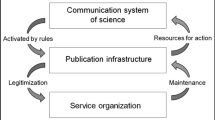Abstract
As members of the Virgo Collaboration—one of the large scientific collaborations that explore the universe of gravitational waves together with the LIGO Scientific Collaboration and the KAGRA Collaboration—we became aware of biased citation practices that exclude Virgo, as well as KAGRA, from achievements that collectively belong to the wider LIGO/Virgo/KAGRA Collaboration. Here, we frame these practices in the context of Merton’s “Matthew effect”, extending the reach of this well-studied cognitive bias to include large international scientific collaborations. We provide qualitative evidence of its occurrence, displaying the network of links among published papers in the scientific literature related to Gravitational Wave science. We note how the keyword “LIGO” is linked to a much larger number of papers and variety of subjects than the keyword “Virgo”. We support these qualitative observations with a quantitative study based on a year-long monitoring of the relevant literature, where we scan all new preprints appearing in the arXiv electronic preprint database. Over the course of one year, we identified all preprints failing to assign due credits to Virgo. As a further step, we undertook positive actions by asking the authors of problematic papers to correct them. Here, we also report on a more in-depth investigation which we performed on problematic preprints that appeared in the first three months of the period under consideration, checking how frequently their authors reacted positively to our request and corrected their papers. Finally, we measure the global impact of papers classified as problematic and observe that, thanks to the changes implemented in response to our requests, the global impact (measured as the number of citations of papers which still contain Virgo visibility issues) was halved. We conclude the paper with general considerations for future work in a wider perspective.









Similar content being viewed by others
Data availability
The manuscript has associated data in a data repository.
Notes
The passage reads: “For unto everyone that hath shall be given, and he shall have abundance; but from him that hath not shall be taken away even that which he hath” (Matthew 25:29).
References
Zuckerman, H.: Nobel Laureates in the United States: A Sociological Study of Scientific Collaboration. PhD thesis, Columbia University (1965)
Zuckerman, H.: Scientific Elite: Nobel Laureates in the United States. The Free Press, New York (1977)
Merton, R.K.: On Social Structure and Science. University of Chicago Press, Chicago (1996)
Merton, R.K.: The Matthew Effect in Science. Science 159(3810), 56–63 (1968) https://doi.org/10.1126/science.159.3810.56
Liao, C.H.: The Matthew effect and the halo effect in research funding. Journal of Informetrics 15(1), 101108 (2021) https://doi.org/10.1016/j.joi.2020.101108
Zhang, S., Wapman, K.H., Larremore, D.B., Clauset, A.: Labor advantages drive the greater productivity of faculty at elite universities. Science Advances 8(46), 7056 (2022) https://doi.org/10.1126/sciadv.abq7056
Perc, M.: The Matthew effect in empirical data. Journal of The Royal Society Interface 11(98), 20140378 (2014) https://doi.org/10.1098/rsif.2014.0378
Katchanov, Y.L., Markova, Y.V., Shmatko, N.A.: Empirical demonstration of the Matthew effect in scientific research careers. Journal of Informetrics 17(4), 101465 (2023) https://doi.org/10.1016/j.joi.2023.101465
LIGO Scientific Collaboration, Virgo Collaboration: Observation of Gravitational Waves from a Binary Black Hole Merger. Physical Review Letters 116(6), 061102 (2016) https://doi.org/10.1103/PhysRevLett.116.061102arXiv:1602.03837 [gr-qc]
Einstein, A.: Näherungsweise Integration der Feldgleichungen der Gravitation. Sitzungsberichte der Königlich Preußischen Akademie der Wissenschaften, 688–696 (1916)
Rothman, T.: The Secret History of Gravitational Waves: Contrary to popular belief, Einstein was not the first to conceive of gravitational waves–but he was, eventually, the first to get the concept right. American Scientist 106(2), 96–104 (2018)
Cervantes-Cota, J.L., Galindo-Uribarri, S., Smoot, G.F.: A brief history of gravitational waves. Universe 2(3), 22 (2016) https://doi.org/10.3390/universe2030022
Abbott, B.P., et al.: GWTC-3: Compact Binary Coalescences Observed by LIGO and Virgo During the Second Part of the Third Observing Run. To appear in Physical Review X (2023) arXiv:2111.03606 [gr-qc]
LSC - LIGO Scientific Collaboration. https://www.ligo.org/about.php. Accessed: 08-11-2023
VMD Public. https://apps.virgo-gw.eu/vmd/public/institutions. Accessed: 08-11-2023
KAGRA Collaboration - KAGRA Large-scale Cryogenic Graviational wave Telescope Project. https://apps.virgo-gw.eu/vmd/public/institutions. Accessed: 08-11-2023
Van Eck, N.J., Waltman, L.: VOSviewer Online. https://doi.org/10.5281/zenodo.7257222
Birkle, C., Pendlebury, D.A., Schnell, J., Adams, J.: Web of Science as a data source for research on scientific and scholarly activity. Quantitative Science Studies 1(1), 363–376 (2020) https://doi.org/10.1162/qss_a_00018
Abbott, B.P., et al.: GW170817: Observation of Gravitational Waves from a Binary Neutron Star Inspiral. Physical Review Letters 119, 161101 (2017) https://doi.org/10.1103/PhysRevLett.119.161101
Branchesi, M.: Multi-messenger astronomy: gravitational waves, neutrinos, photons, and cosmic rays. In: Journal of Physics: Conference Series, vol. 718, p. 022004 (2016). https://doi.org/10.1088/1742-6596/718/2/022004. IOP Publishing
Abbott, B.P., et al.: Multi-messenger Observations of a Binary Neutron Star Merger. The Astrophysical Journal Letters 848(2), 12 (2017) https://doi.org/10.3847/2041-8213/aa91c9arXiv:1710.05833 [astro-ph.HE]
arXiv. https://arxiv.org/. Accessed: 09-11-2023
Martín-Martín, A., Orduna-Malea, E., Thelwall, M., Delgado López-Cózar, E.: Google Scholar, Web of Science, and Scopus: A systematic comparison of citations in 252 subject categories. Journal of Informetrics 12(4), 1160–1177 (2018) https://doi.org/10.1016/j.joi.2018.09.002
LVKVisibility. https://github.com/edymil/LVKVisibility. Accessed: 09-11-2023
Author information
Authors and Affiliations
Corresponding author
Rights and permissions
Springer Nature or its licensor (e.g. a society or other partner) holds exclusive rights to this article under a publishing agreement with the author(s) or other rightsholder(s); author self-archiving of the accepted manuscript version of this article is solely governed by the terms of such publishing agreement and applicable law.
About this article
Cite this article
Barneo, P., Cabras, G., Cohadon, PF. et al. Addressing the problem of the LIGO–Virgo–KAGRA visibility in the scientific literature. EPJ H 49, 2 (2024). https://doi.org/10.1140/epjh/s13129-023-00066-z
Received:
Accepted:
Published:
DOI: https://doi.org/10.1140/epjh/s13129-023-00066-z




